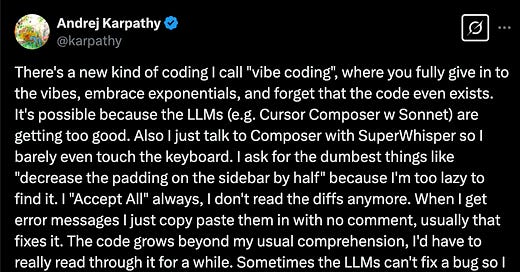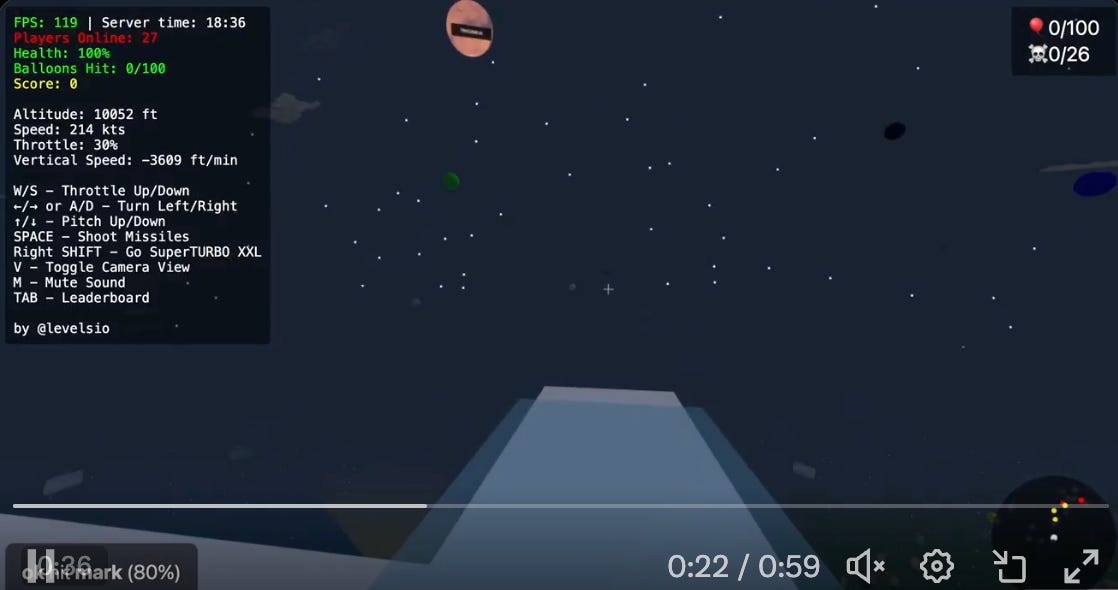Welcome to the era of “vibe coding,” where writing software feels less like grinding through syntax and more like jamming with an AI on your ideas. Instead of meticulously crafting every line of code, developers (and even total beginners) are describing what they want in plain English and letting AI-driven tools handle the heavy lifting. As one commenter put it, the new mindset is “just speak English and vibe with the thing, don’t worry about the code”
It all started with a tweet from Andrej Karpathy, an AI-legend.
Less syntax, more vibes
So, what exactly is vibe coding? Think of it as letting AI be your co-pilot (or rather, your chauffeur) in coding. You tell it what you want – and it writes the code. Your job shifts from typing out syntax to guiding, reviewing, and tweaking.
In other words, you become the idea person and editor, while the AI handles the boilerplate and minutiae.
This trend has exploded with the rise of AI-assisted development tools. Cursor, an AI-powered code editor, is at the forefront of the vibe coding wave. Unlike simpler autocomplete tools (looking at you, Copilot), Cursor can ingest your entire project context and generate or modify multiple files at once.
Because it “knows” your project, you can ask it to implement features or fixes across the codebase in one go.
So what are people actually making?
Still skeptical? Understandable. I’ve seen people saying things like “I can’t wait to get paid $200/hr to fix all the things these vibe coders break.”
I’m not convinced “vibe coding” replaces good software development skills, but it raises the floor significantly. I’ve used Cursor and other tools for many months now, but recently I rode the vibe coding wave and made an app without writing a single line of code. With no React Native experience, I built a simple medicine tracking app and shipped it to the app store in less than two hours. In another two hour stretch, I built a software engineering resource directory, complete with an admin panel. These are things I could’ve done without AI, sure, but it would’ve taken me so much longer.
What else are people making online?
Three.js games by an 8‑Year‑Old
One proud dad on Twitter shared that his 8-year-old son built a Three.js web game and several mini apps using AI – “letting Cursor do all the coding for him”. The boy created “two platform games, a drawing app, an animation app, and an AI chat app” in about 2 hours each, despite having zero prior programming experience. These kids aren’t slogging through “Hello World” tutorials – they’re having a blast bringing their ideas to life with AI as their helper.
A development toolkit
Someone on the Cursor forms built “DevTools,” a suite of developer utilities (JSON formatter, RegEx tester, color generator, etc.) entirely using Cursor’s AI Composer. “I was able to quickly generate code, refine logic, and troubleshoot in real-time, making the development process incredibly efficient”
A flight simulator (made $38k in 10 days)
Another builder shipped a flight simulator built with Cursor, pulling in $38,000 in ten days.
What does it all mean?
The vibe coding trends hints at a deeper shift in software development. Coding is no longer the exclusive domain of those who’ve spent years mastering syntax and algorithms – it’s becoming more about imagination and building things people want. I say this as someone who’s spent years doing software as a profession.
Experienced engineers will still dive in and hand-tune as needed, but they can also choose to operate at a higher level, orchestrating the AI like a conductor. I wrote more about this here👇
The important shift here is for newbies who might have been intimidated by the steep learning curve of software development. Today, folks can jump straight into building something that excites them.
That’s not to say vibe coding comes without challenges. AI-generated code can be hit-or-miss, and if you’re working on a serious production project, you’ll still need to verify and clean up what the AI produces.
Vibe coding is about having fun building things, not having fun writing code.






